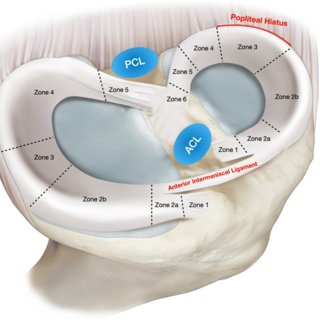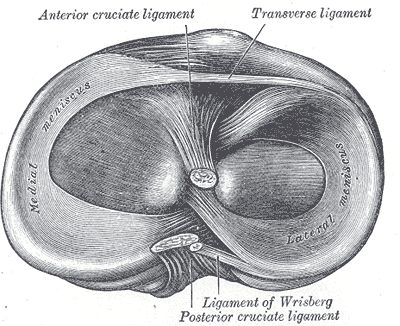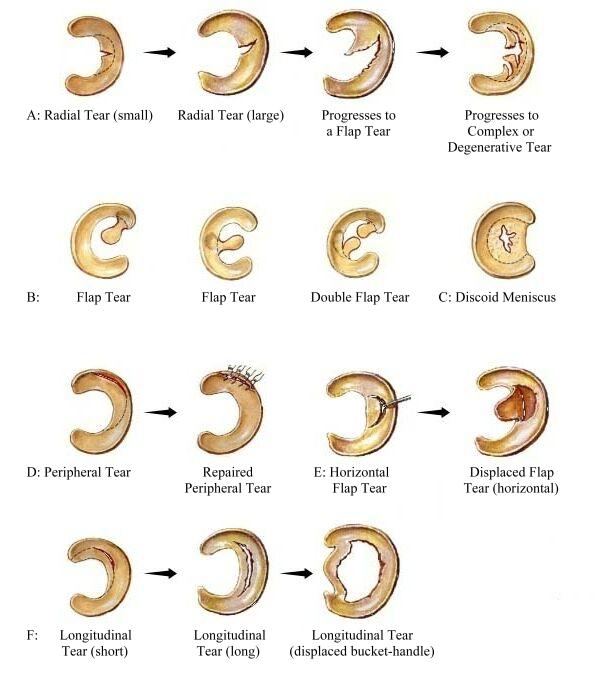Medial Meniscus: Difference between revisions
Maram Salem (talk | contribs) No edit summary |
Maram Salem (talk | contribs) (formatted headings, added up to date references, added relevant information. Corrected grammar. Checked spelling. Added a new photo for reference.) |
||
| Line 8: | Line 8: | ||
== Introduction == | == Introduction == | ||
The | The menisci are fibrocartilaginous structures that function to deepen the tibial plateau, improve articulation of the femur on the tibia, stabilize the knee, and assist with shock absorption.<ref name=":0">Mameri ES, Dasari SP, Fortier LM, Verdejo FG, Gursoy S, Yanke AB, Chahla J. Review of meniscus anatomy and biomechanics. Current Reviews in Musculoskeletal Medicine. 2022 Oct;15(5):323-35.</ref> The medial meniscus specifically forms almost a semicircular shape and covers 50-60% of the articular surface between the medial femoral condyle and the medial tibial plateau.<ref>Śmigielski R, Becker R, Zdanowicz U, Ciszek B. Medial meniscus anatomy—from basic science to treatment. Knee Surgery, Sports Traumatology, Arthroscopy. 2015 Jan;23:8-14.</ref> It has a vascular supply and receives innervation from the posterior tibial, obturator, and femoral nerves.<ref name=":1">Farrell C, Shamrock AG, Black AC, Kiel J. Anatomy, Bony Pelvis and Lower Limb: Medial Meniscus. InStatPearls [Internet] 2023 Apr 4. StatPearls Publishing.</ref> The medial meniscus is located on the medial portion of the tibial plateau. | ||
== Anatomy and | == Anatomy and Attachment == | ||
[[File:Medial-and-lateral-meniscus-zones-and-relevant-anatomical-relations-ACL-anterior Q320.jpeg|frame|<ref>Review of Meniscus Anatomy and Biomechanics - Scientific Figure on ResearchGate. Available from: <nowiki>https://www.researchgate.net/figure/Medial-and-lateral-meniscus-zones-and-relevant-anatomical-relations-ACL-anterior_fig1_362618200</nowiki> [accessed 20 Jan, 2024]</ref>]] | |||
The medial meniscus is approximately 1.4 in (3.5cm) in length. It maintains the same thickness from posterior to anterior.<ref name=":0" /> The medial meniscus can be divided into five anteroposterior zones. Zone 1 refers to the anterior root attachment. Zones 2a and 2b refer to the anteromedial zone between the posterior border of the anterior root and the anterior border of the superficial medial collateral ligament. Zone 3 refers to the portion of the medial meniscus that is next to the [[Medial Collateral Ligament of the Knee|medial collateral ligament]]. Zone 4 refers to the posterior horn, and zone 5 refers to the posterior root.<ref name=":0" /> | |||
The medial meniscus is | The medial meniscus is attached to the tibial plateau via its anterior horn and posterior horn. The anterior horn of the medial meniscus is attached to the anterior surface of the tibia at the tibial plateau. The anterior horn merges with the fibers of the transverse ligament and the [[Anterior Cruciate Ligament (ACL)|ACL]] ligament on the tibia.<ref name=":1" /> The posterior horn of the medial meniscus is firmly attached to the posterior aspect of the joint capsule. Medially, the medial meniscus is attached to the [[Medial Collateral Ligament of the Knee|medial collateral ligament]], limiting its mobility. The medial meniscus has no direct attachment to any muscle, but indirect capsule connections to the semimembranosus may provide some retraction of the posterior horn. <ref name=":1" /> | ||
[[ | Compared to the [[lateral meniscus]], the medial meniscus is a definitive crescent "C" shape, has less variability with size and thickness, and covers a smaller part of the tibial plateau.<ref name=":1" /> Anteriorly, it is attached to lateral meniscus by transverse ligament and patella directly or by anterior capsular thickenings called patellomeniscal ligaments <ref>Tuxoe JI, Teir M, Winge S, et al.: The medial patellofemoral ligament: A dissection study. Knee Surg Sports Traumatol Arthrosc 10:138–140, 2002.</ref>. | ||
[[Image:Meniscus sup view Gray349.png|center]]<br> | |||
== Vascular Supply == | |||
The vascular supply of the menisci originates predominately from the | The vascular supply of the menisci originates predominately from the medial, lateral, and middle genicular arteries. These three arteries are branches of the popliteal artery. The primary areas of vascularity are the superior and inferior portions of the meniscus, making only 10-30% of the meniscus a recipient of direct blood supply. The remaining portion of the medial meniscus is replenished with nutrients via diffusion of the synovial fluid.<ref>McCarty EC, Marx RG, DeHaven KE: Meniscus repair: Considerations in treatment and update of clinical results. Clin Orthop 402:122–134, 2002.</ref> Due to the lack of direct blood supply to most of the structure, the medial meniscus has difficulty healing after an injury or during the post-operative process. | ||
== Nerve Supply == | |||
The medial meniscus is innervated by branches of the posterior tibial nerve and the terminal branches of the obturator and femoral nerves. The nerve fibers joint together and innervate the joint capsule.<ref name=":1" /> The anterior and posterior horns of the medial meniscus innervated with free nerve endings (nociceptors) and three different mechanoreceptors (Ruffini corpuscles, Pacinian corpuscles, and Golgi tendon organs).<ref name="gray">Gray JC: Neural and vascular anatomy of the menisci of the human knee. J Orthop Sports Phys Ther 29:23–30, 1999.</ref><ref>Zimny ML, Albright DJ, Dabezies E: Mechanoreceptors in the human medial meniscus. Acta Anat (Basel) 133:35–40, 1988.</ref><ref>Mine T, Kimura M, Sakka A, et al.: Innervation of nociceptors in the menisci of the knee joint: An immunohistochemical study. Arch Orthop Trauma Surg 120:201–204, 2000.</ref> These different mechanoreceptors help the knee joint support and adapt to various movements. | |||
The horns of the | |||
== Injury/Tear == | == Injury/Tear == | ||
| Line 52: | Line 52: | ||
*X-ray | *X-ray | ||
*MRI | *MRI | ||
== Special Tests == | |||
Although there are several tests for a meniscus tear, none can be considered definitive without considerable experience on the part of the examiner. Patient history and the mechanism of injury also provide a major source of information. The most commonly used special tests are... | Although there are several tests for a meniscus tear, none can be considered definitive without considerable experience on the part of the examiner. Patient history and the mechanism of injury also provide a major source of information. The most commonly used special tests are... | ||
| Line 62: | Line 60: | ||
*[http://www.physio-pedia.com/Ege%27s_Test Ege's test] | *[http://www.physio-pedia.com/Ege%27s_Test Ege's test] | ||
*[http://www.physio-pedia.com/Thessaly_test Thessaly test] | *[http://www.physio-pedia.com/Thessaly_test Thessaly test] | ||
== Imaging == | |||
'''X-Ray''': | '''X-Ray''': | ||
Revision as of 03:57, 20 January 2024
Original Editor - Aarti Sareen
Top Contributors - Aarti Sareen, Kim Jackson, Maram Salem, Admin, WikiSysop, Fasuba Ayobami, Jonathan Wong, Rachael Lowe, Evan Thomas and Oyemi Sillo
Introduction[edit | edit source]
The menisci are fibrocartilaginous structures that function to deepen the tibial plateau, improve articulation of the femur on the tibia, stabilize the knee, and assist with shock absorption.[1] The medial meniscus specifically forms almost a semicircular shape and covers 50-60% of the articular surface between the medial femoral condyle and the medial tibial plateau.[2] It has a vascular supply and receives innervation from the posterior tibial, obturator, and femoral nerves.[3] The medial meniscus is located on the medial portion of the tibial plateau.
Anatomy and Attachment[edit | edit source]
The medial meniscus is approximately 1.4 in (3.5cm) in length. It maintains the same thickness from posterior to anterior.[1] The medial meniscus can be divided into five anteroposterior zones. Zone 1 refers to the anterior root attachment. Zones 2a and 2b refer to the anteromedial zone between the posterior border of the anterior root and the anterior border of the superficial medial collateral ligament. Zone 3 refers to the portion of the medial meniscus that is next to the medial collateral ligament. Zone 4 refers to the posterior horn, and zone 5 refers to the posterior root.[1]
The medial meniscus is attached to the tibial plateau via its anterior horn and posterior horn. The anterior horn of the medial meniscus is attached to the anterior surface of the tibia at the tibial plateau. The anterior horn merges with the fibers of the transverse ligament and the ACL ligament on the tibia.[3] The posterior horn of the medial meniscus is firmly attached to the posterior aspect of the joint capsule. Medially, the medial meniscus is attached to the medial collateral ligament, limiting its mobility. The medial meniscus has no direct attachment to any muscle, but indirect capsule connections to the semimembranosus may provide some retraction of the posterior horn. [3]
Compared to the lateral meniscus, the medial meniscus is a definitive crescent "C" shape, has less variability with size and thickness, and covers a smaller part of the tibial plateau.[3] Anteriorly, it is attached to lateral meniscus by transverse ligament and patella directly or by anterior capsular thickenings called patellomeniscal ligaments [5].
Vascular Supply[edit | edit source]
The vascular supply of the menisci originates predominately from the medial, lateral, and middle genicular arteries. These three arteries are branches of the popliteal artery. The primary areas of vascularity are the superior and inferior portions of the meniscus, making only 10-30% of the meniscus a recipient of direct blood supply. The remaining portion of the medial meniscus is replenished with nutrients via diffusion of the synovial fluid.[6] Due to the lack of direct blood supply to most of the structure, the medial meniscus has difficulty healing after an injury or during the post-operative process.
Nerve Supply[edit | edit source]
The medial meniscus is innervated by branches of the posterior tibial nerve and the terminal branches of the obturator and femoral nerves. The nerve fibers joint together and innervate the joint capsule.[3] The anterior and posterior horns of the medial meniscus innervated with free nerve endings (nociceptors) and three different mechanoreceptors (Ruffini corpuscles, Pacinian corpuscles, and Golgi tendon organs).[7][8][9] These different mechanoreceptors help the knee joint support and adapt to various movements.
Injury/Tear[edit | edit source]
The most common mechanism of menisci injury is a twisting injury with the foot anchor on the ground, often by another player's body. A slow twisting force may also cause the tear.Damage to the meniscus is due to rotational forces directed to a flexed knee (as may occur with twisting sports) is the usual underlying mechanism of injury [10][11]. The meniscal tear is of following types:
- Longitudinal
- Radial
- Bucket handle
- Flap
- Horizontal cleavage
- Degenerative
Meniscus injuries commonly occur in contact sports; often in combination with ligament injuries, particularly when the medial meniscus is involved. This is partly because the medial meniscus is attached to the medial collateral ligament, and partly because tackles are often directed towards the lateral side of the knee, causing external rotation of the tibia. Injury to the medial meniscus is about 5 times more common than injury to the lateral meniscus. In cases of external rotation of the foot and lower leg in relation to the femur, the medial meniscus is most vulnerable. A varus force applied to the flexed knee when the foot is planted and the femur rotated internally can result in a tear of the medial meniscus.
The patient comes up with major complain of knee pain, swelling and knee locking which is when the patient is unable to straighten the leg fully. This can be accompanied by a clicking feeling.
The diagnosis of an medial meniscus injury is considered to be fairly certain if three or more of the following findings are present:[10]
- Tenderness at one point over the medial joint line
- Pain in the area of the medial joint line during hyperextension of the knee joint
- Pain in the area of the medial joint line during hyperflexion of the knee joint
- Pain during external rotation of the foot and the lower leg when the knee is flexed at different angles around 70–90°
- Weakened or hypotrophied quadriceps muscle.
Diagnosis[edit | edit source]
Diagnosis can be made on the basis of
- Special test
- X-ray
- MRI
Special Tests[edit | edit source]
Although there are several tests for a meniscus tear, none can be considered definitive without considerable experience on the part of the examiner. Patient history and the mechanism of injury also provide a major source of information. The most commonly used special tests are...
Imaging[edit | edit source]
X-Ray:
X-ray is done in weight-bearing but is not helpful in detecting the medial meniscal tear, but, can detect other associated conditions at bony level.
Magnetic Resonance Imaging:
Meniscal tear can be well appreciated on an MRI.
Resources[edit | edit source]
Clinical Practice Guideline: Meniscal and Articular Cartilage Lesions
References[edit | edit source]
- ↑ 1.0 1.1 1.2 Mameri ES, Dasari SP, Fortier LM, Verdejo FG, Gursoy S, Yanke AB, Chahla J. Review of meniscus anatomy and biomechanics. Current Reviews in Musculoskeletal Medicine. 2022 Oct;15(5):323-35.
- ↑ Śmigielski R, Becker R, Zdanowicz U, Ciszek B. Medial meniscus anatomy—from basic science to treatment. Knee Surgery, Sports Traumatology, Arthroscopy. 2015 Jan;23:8-14.
- ↑ 3.0 3.1 3.2 3.3 3.4 Farrell C, Shamrock AG, Black AC, Kiel J. Anatomy, Bony Pelvis and Lower Limb: Medial Meniscus. InStatPearls [Internet] 2023 Apr 4. StatPearls Publishing.
- ↑ Review of Meniscus Anatomy and Biomechanics - Scientific Figure on ResearchGate. Available from: https://www.researchgate.net/figure/Medial-and-lateral-meniscus-zones-and-relevant-anatomical-relations-ACL-anterior_fig1_362618200 [accessed 20 Jan, 2024]
- ↑ Tuxoe JI, Teir M, Winge S, et al.: The medial patellofemoral ligament: A dissection study. Knee Surg Sports Traumatol Arthrosc 10:138–140, 2002.
- ↑ McCarty EC, Marx RG, DeHaven KE: Meniscus repair: Considerations in treatment and update of clinical results. Clin Orthop 402:122–134, 2002.
- ↑ Gray JC: Neural and vascular anatomy of the menisci of the human knee. J Orthop Sports Phys Ther 29:23–30, 1999.
- ↑ Zimny ML, Albright DJ, Dabezies E: Mechanoreceptors in the human medial meniscus. Acta Anat (Basel) 133:35–40, 1988.
- ↑ Mine T, Kimura M, Sakka A, et al.: Innervation of nociceptors in the menisci of the knee joint: An immunohistochemical study. Arch Orthop Trauma Surg 120:201–204, 2000.
- ↑ 10.0 10.1 Peterson,Renström. SPORTS INJURIES:Their Prevention and Treatment.Third Edition.
- ↑ Brunker,Khan.Clinical Sports Medicine.3rd Edition.









